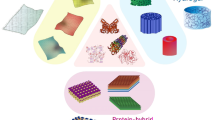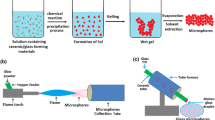Abstract
Polyurethane (PUR) is a well-established biocompatible material intended to augment the body regenerations. To enhance the compatibility, PUR was combined with bovine hydroxyapatite (BHA) extracted from waste bones. The HA consider as a chief bone mineral to maintain the rigidity of the structure. The PUR was synthesized by prepolymer process and mixed with BHA (5% and 10%) by solvent casting technique. The synthesis of PUR and composites was confirmed by characteristic bands from FTIR spectra. The crystallite size of BHA was 465A° with a hexagonal structure confirmed by XRD. Moreover, XRD supported the incorporation of BHA into PUR matrix. The thermal stability of composites was significantly enhanced by the addition of BHA into PUR. A rough morphology of composites was revealed by SEM which may support for end application. The biodegradability of composites was superior in simulated body fluid. In-vitro MTT antitumor bioassay established the cytocompatible nature of synthesized materials. The composites demonstrated enriched cell viability with an increase in the content of BHA. Hence, these results suggested a green and economic approach for synthesis of biodegradable and cytocompatible materials for tissue regeneration.







Similar content being viewed by others
References
Deligianni DD, Katsala ND, Koutsoukos PG et al (2000) Effect of surface roughness of hydroxyapatite on human bone marrow cell adhesion, proliferation, differentiation and detachment strength. Biomaterials 22:87–96
Dahham KM, Nainar MAM (2013) Mechanical properties and morphological studies on Pu-Ha biocomposite. I J S R 2:2319
Kariduraganavar MY, Tambe SM, Tasaganva RG et al (2011) Studies on nonlinear optical polyurethanes containing heterocyclic chromophores. J Mol Struct 987:158–165
Eliaz N, Shmueli S, Shur I, Benayahu D et al (2009) The effect of surface treatment on the surface texture and contact angle of electrochemically deposited hydroxyapatite coating and on its interaction with bone-forming cells. Acta Biomater 5:3178–3191
Ramay HR, Zhang M (2003) Preparation of porous hydroxyapatite scaffolds by combination of the gel-casting and polymer sponge methods. Biomaterials 24:3293–3302
Prabakaran K, Rajeswari S (2006) Development of hydroxyapatite from natural fish bone through heat treatment. Trends Biomaterials Artificial Organs 20:20–23
Hosseinzadeh E, Davarpanah M, Nemati NH et al (2014) Fabrication of a hard tissue replacement using natural hydroxyapatite derived from bovine bones by thermal decomposition method. Int J Organ Transplant Med 5:23
Khoo W, Nor FM, Ardhyananta H et al (2015) Preparation of natural hydroxyapatite from bovine femur bones using calcination at various temperatures. Procedia Manuf 2:196–201
Wang H, Li Y, Zuo Y et al (2007) Biocompatibility and osteogenesis of biomimetic nano-hydroxyapatite/polyamide composite scaffolds for bone tissue engineering. Biomaterials 28:3338–3348
Wang X, Min BG (2008) Comparison of porous poly (vinyl alcohol)/hydroxyapatite composite cryogels and cryogels immobilized on poly (vinyl alcohol) and polyurethane foams for removal of cadmium. J Hazard Mater 156:381–386
Dyshlovenko S, Pierlot C, Pawlowski L et al (2006) Experimental design of plasma spraying and laser treatment of hydroxyapatite coatings. Surf Coat Technol 201:2054–2060
Cateto CA, Barreiro MF, Rodrigues AE (2008) Monitoring of lignin-based polyurethane synthesis by FTIR-ATR Ind crops. Prod 27:168–174
Sultan M (2018) Hydroxyapatite/polyurethane composites as promising biomaterials. Chem Pap 72:2375–2395
Gabriel LP, dos Santos MEM, Jardini AL et al (2017) Bio-based polyurethane for tissue engineering applications: How hydroxyapatite nanoparticles influence the structure, thermal and biological behavior of polyurethane composites. Nanomed Nanotechnol 13:201–208
Kumar L, Ahuja D (2019) Preparation and characterization of aliphatic polyurethane and modified hydroxyapatite composites for bone tissue engineering. Polym Bull 1–14
Calderón J A G, López D C, Pérez E et al (2019) Polysiloxanes as polymer matrices in biomedical engineering: their interesting properties as the reason for the use in medical sciences. Polym Bull 1–69
Arslan A K, Alkan F (2020) PHBHX–HA–OXG bone graft: in-vitro characterization. Polym Bull
Patel S, Gheewala N, Suthar A et al (2009) In-vitro cytotoxicity activity of Solanum nigrum extract against Hela cell line and Vero cell line. Int J Pharm Pharm Sci 1:38–46
Sultan M, Javeed A, Uroos M, Imran M et al (2018) Linear and crosslinked polyurethanes based catalysts for reduction of methylene blue. J Hazard Mater 344:210–219
Sultan M, Atta S, Bhatti HN et al (2017) Synthesis, characterization, and application studies of polyurethane acrylate thermoset coatings: effect of hard segment. Polymer Plast Technol Eng 56:1608–1618
Effendi MD, Gustiono D, Ayu D et al (2017) Comparison on mechanical properties of single layered and bilayered chitosan-gelatin coated porous hydroxyapatite scaffold prepared through freeze drying method. IOP conf ser Mater sci eng 17:012031
Rahman MM (2017) Improvements of antimicrobial and barrier properties of waterborne polyurethane containing hydroxyapatite-silver nanoparticles. J Adhes Sci Technol 31:613–626
Bozkurt Y, Sahin A, Sunulu A et al (2017) Electrospun nanocomposite materials, a novel synergy of polyurethane and bovine derived hydroxyapatite. J Phys A Conference Series 829:012015
Jiang J, Li L, Li K et al (2016) Antibacterial nanohydroxyapatite/polyurethane composite scaffolds with silver phosphate particles for bone regeneration. J Biomater Sci Polym 27:1584–1598
Ratnakar A, Prasad KH, Vivekananthan S et al (2016) Synthesis and characterization of polyurethane-titanium dioxide–hydroxyapatite nanocomposite for biomedical applications. Materials Today Proceedings 3:4052–4057
Gogoi S, Kumar M, Mandal BB et al (2016) A renewable resource based carbon dot decorated hydroxyapatite nanohybrid and its fabrication with waterborne hyperbranched polyurethane for bone tissue engineering. RSC Adv 6:26066–26076
Marycz K, Marędziak M, Grzesiak J et al (2016) Biphasic polyurethane/polylactide sponges doped with nano-hydroxyapatite (nHAp) combined with human adipose-derived mesenchymal stromal stem cells for regenerative medicine applications. A Polym 8:339
Marycz K, Marędziak M, Grzesiak J et al (2017) High performance shape memory foams with isocyanate-modified hydroxyapatite nanoparticles for minimally invasive bone regeneration. Ceram Int 43:4794–4802
Song EH, Cho KI, Kim HE et al (2017) Biomimetic coating of hydroxyapatite on glycerol phosphate-conjugated polyurethane via mineralization. ACS omega 2:981–987
Fu SZ, Meng XH, Fan J et al (2014) In vitro and in vivo degradation behavior of n-HA/PCL-Pluronic-PCL polyurethane composites. J Biomed Mater Res A 102:479–486
Author information
Authors and Affiliations
Corresponding author
Additional information
Publisher's Note
Springer Nature remains neutral with regard to jurisdictional claims in published maps and institutional affiliations.
Rights and permissions
About this article
Cite this article
Parveen, S., Sultan, M., Sajid, M.I. et al. Synthesis and characterization of biodegradable and cytocompatible polyurethane-bovine-derived hydroxyapatite biomaterials. Polym. Bull. 79, 2487–2500 (2022). https://doi.org/10.1007/s00289-021-03622-z
Received:
Revised:
Accepted:
Published:
Issue Date:
DOI: https://doi.org/10.1007/s00289-021-03622-z




